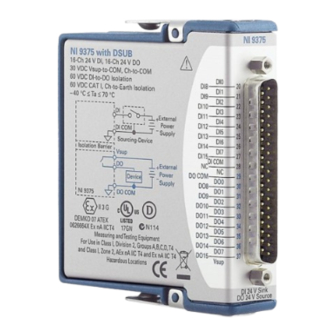
National Instruments NI-9375 Getting Started
Hide thumbs
Also See for NI-9375:
- Getting started manual (21 pages) ,
- Getting started manual (23 pages) ,
- Getting started (11 pages)
Advertisement
Quick Links
Advertisement

Subscribe to Our Youtube Channel
Summary of Contents for National Instruments NI-9375
- Page 1 NI-9375 Getting Started 2023-08-02...
- Page 2 NI-9375 Getting Started........
- Page 3 NI-9375 Getting Started NI-9375 Getting Started Connector Types The NI-9375 has more than one connector type: NI-9375 with spring terminal and NI-9375 with DSUB. Unless the connector type is specified, NI-9375 refers to all connector types. The NI-9375 with spring terminal is available in two types: push-in spring terminal and spring terminal.
- Page 4 + … + I = Total Module Current DO15 For example, an NI-9375 with spring terminal with two channels at 250 mA, six channels at 125 mA, and eight channels at 62 mA has the following per module continuous output current.
- Page 5 DI COM Common reference connection for the digital inputs Digital output signal connection DO COM Common reference connection for the digital outputs No connection Voltage supply connection NI-9375 with Push-in Style Spring Terminal (Black/ Orange Connector) Pinout © National Instruments...
- Page 6 Table 2. Signal Descriptions Signal Description Digital input signal connection DI COM Common reference connection for the digital inputs Digital output signal connection DO COM Common reference connection for the digital outputs No connection Voltage supply connection NI-9375 with DSUB Pinout ni.com...
-
Page 7: Sourcing-Output Connections
DI COM – Supply NI 9375 The NI-9375 channel registers as ON when the sourcing-output device drives enough current or applies enough voltage to DI. If no device is connected to DI, the channel registers as OFF. © National Instruments... -
Page 8: Connecting Digital Devices
Connecting Digital Devices You can connect a variety of industrial devices, such as solenoids, motors, actuators, relays, and lamps to the NI-9375. You must connect an external power supply to the NI-9375. The power supply provides the current for the output channels. - Page 9 Inductive Diode Device DO COM NI 9375 Connecting Wires to the NI-9375 with Spring Terminal (Black Connector) What to Use NI-9375 spring terminal black connector ■ 0.08 mm to 1.0 mm (28 AWG to 18 AWG) copper conductor wire with 7 mm ■...
-
Page 10: High-Vibration Application Connections
You must use 2-wire ferrules to create a secure connection when connecting more than one wire to a single terminal. High-Vibration Application Connections If your application is subject to high vibration, NI recommends that you use the NI-9940 backshell kit to protect connections to the NI-9375 with spring terminal. ni.com... - Page 11 An overcurrent state can affect the performance of the NI-9375 and other modules in the system. To ensure safe and proper operation, the digital outputs should not exceed the maximum continuous output current specification.









Need help?
Do you have a question about the NI-9375 and is the answer not in the manual?
Questions and answers